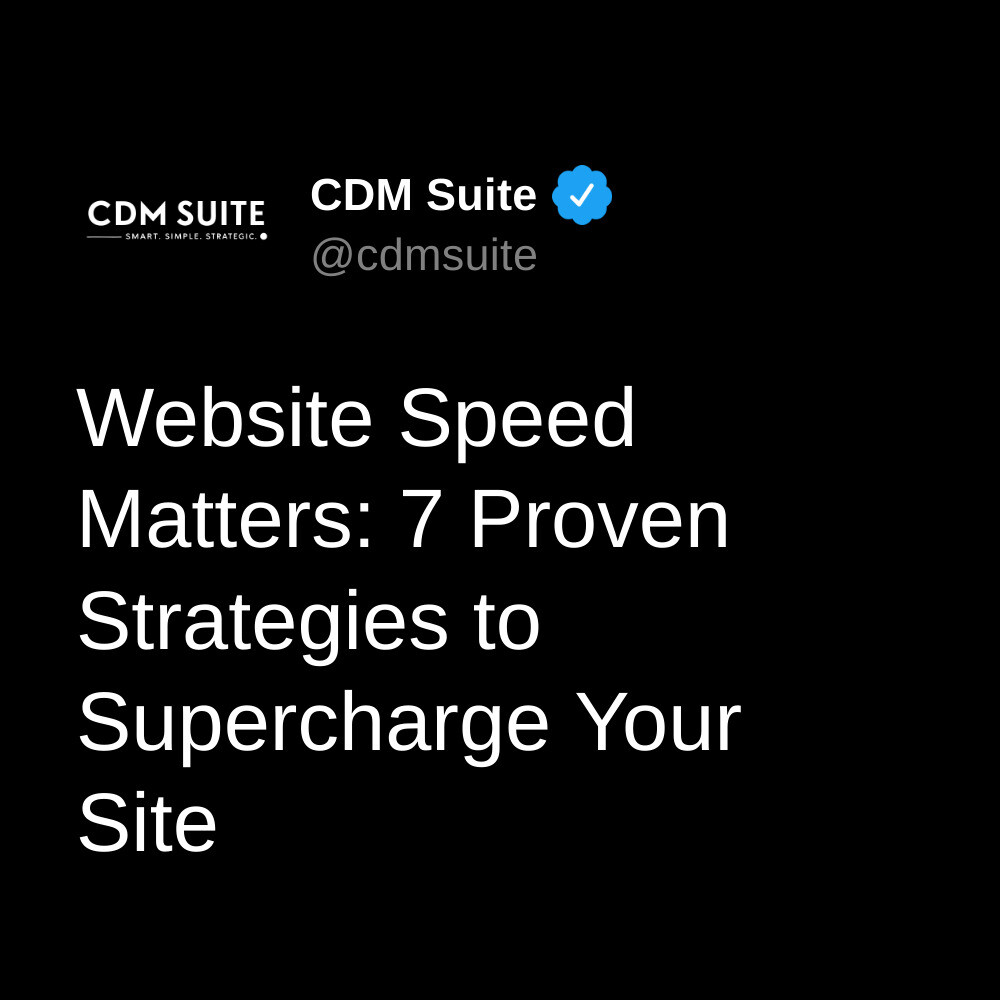Website Speed Matters: 7 Proven Strategies to Supercharge Your Site
In the lightning-fast digital landscape of 2025, website speed isn’t just a luxury—it’s a necessity. Did you know that a mere 1-second delay in page load time can lead to a 7% reduction in conversions? That’s right, your slow website could be costing you customers and revenue without you even realizing it.
As a digital marketing strategist, I’ve seen firsthand how website speed can make or break online success. In this post, we’ll dive deep into why speed matters more than ever and, more importantly, how you can fix a slow website to stay competitive in today’s market.
Why Website Speed is Critical in 2025
The User Experience Factor
In 2025, user expectations for website performance have reached new heights. A staggering 83% of users expect websites to load in 3 seconds or less. This impatience isn’t surprising when you consider that we live in an era of instant gratification, where information and services are expected to be available at our fingertips.
SEO and Rankings
Search engines, particularly Google, have long considered page speed as a ranking factor. But in 2025, it’s more crucial than ever. Websites appearing on the first page of Google search results take an average of 1.65 seconds to load. If your site is lagging behind, you’re not just frustrating users—you’re potentially invisible to them in the first place.
Mobile-First World
With mobile browsing dominating internet usage, speed optimization for mobile devices is non-negotiable. In fact, 53% of mobile site visits are abandoned if pages take longer than 3 seconds to load. In a mobile-first world, slow load times on smartphones can devastate your online presence.
The Bottom Line: Conversions and Revenue
Perhaps the most compelling reason to care about website speed is its direct impact on your business’s bottom line. Slow-loading websites lead to an annual loss of $2.6 billion in sales for businesses. In contrast, faster sites drive more conversions, higher engagement, and increased customer satisfaction.
Now that we’ve established why speed matters, let’s dive into how you can supercharge your website’s performance.
7 Proven Strategies to Fix a Slow Website
1. Optimize Your Images
Images often account for the majority of a webpage’s weight. Implement these tactics to lighten the load:
- Compress images using tools like TinyPNG or Compressor.io
- Use modern image formats like WebP for better compression
- Implement lazy loading to defer off-screen images
By optimizing your images, you can significantly reduce page load times without sacrificing visual quality.
2. Leverage Browser Caching
Browser caching allows returning visitors to load your site more quickly by storing some files locally in their browser. To implement:
- Set appropriate cache-control headers
- Use plugins or server configurations to enable caching
- Determine optimal cache duration for different types of content
Effective caching can dramatically improve load times for repeat visitors, enhancing overall user experience.
3. Minify and Combine Files
Reduce the number of requests your site makes by minifying and combining your CSS, JavaScript, and HTML files:
- Use tools like Webpack or Grunt to automate minification
- Combine multiple CSS and JavaScript files into single files
- Remove unnecessary characters, white space, and comments from your code
This strategy not only reduces file sizes but also decreases the number of HTTP requests, speeding up your site significantly.
4. Utilize a Content Delivery Network (CDN)
A CDN can drastically improve your site’s speed by serving content from servers geographically closer to your users:
- Choose a reliable CDN provider like Cloudflare or Akamai
- Configure your CDN to cache static assets
- Use CDN features like image optimization and security enhancements
By reducing the physical distance data needs to travel, a CDN can shave precious milliseconds off your load times.
5. Optimize Server Response Time
Your server’s response time is crucial for overall site speed. Here’s how to improve it:
- Upgrade your hosting plan or switch to a faster provider
- Implement server-side caching
- Optimize database queries and indexes
A faster server response time sets the foundation for a speedy website experience.
6. Enable Gzip Compression
Gzip compression can reduce the size of your transferred files by up to 70%:
- Enable Gzip compression on your web server
- Ensure all text-based files (HTML, CSS, JavaScript) are compressed
- Verify compression is working using online tools
This simple yet effective technique can significantly reduce data transfer times, especially for text-heavy websites.
7. Implement Asynchronous Loading for CSS and JavaScript
Asynchronous loading allows multiple files to load simultaneously, reducing overall load time:
- Use the ‘async’ attribute for non-essential scripts
- Defer loading of non-critical CSS and JavaScript
- Prioritize above-the-fold content loading
By optimizing how your resources load, you can improve perceived load times and enhance user experience.
Measuring Your Success
After implementing these strategies, it’s crucial to measure your progress. Use tools like Google PageSpeed Insights, GTmetrix, or WebPageTest to analyze your site’s performance before and after optimization.
Remember, website speed optimization is an ongoing process. As technologies evolve and user expectations change, continually monitoring and improving your site’s performance is key to staying ahead in the digital race.
The Future of Website Speed
Looking ahead, emerging technologies like 5G networks and advanced browser capabilities will further raise the bar for website performance. Staying informed about these trends and continuously optimizing your site will be crucial for maintaining a competitive edge.
Conclusion: Speed as a Competitive Advantage
In 2025, website speed is more than just a technical consideration—it’s a fundamental aspect of user experience, SEO, and business success. By implementing the strategies outlined in this post, you can transform your slow website into a high-performance engine that drives engagement, conversions, and growth.
Remember, every second counts in the digital world. Don’t let a slow website hold your business back. Take action today to speed up your site and stay ahead of the competition.
Ready to take your digital marketing strategy to the next level? Don’t stop at just improving your website speed. Visit CDM Suite’s free 3-minute marketing assessment to get a custom growth plan and find out exactly what’s missing in your marketing strategy. Your faster, more successful online presence awaits!



